How to Get Rid Of Mice
36 min read Updated for March, 2019
These furry rodents are among the most common of pests around the world. Yet three kinds common to the U.S. will make homeowners take notice because of the risk for communicable disease.
36 min read Updated for March, 2019

Mouse Sounds
Mice are actually very vocal and communicative animals. While we hear their sounds as squeaks, they have a variety of squeaks and pitches that determine what they’re trying to communicate. Mind you, you’re more likely to notice a mouse by its scratching and scurrying sounds as it scampers inside walls, along baseboards, or in the attic.
Mouse Tracks
Like most rodents, mice have four toes on their front feet with a central pad, and five on their back, and their tiny tracks (half an inch or less) are accompanied by a tail trail.
Mouse Poop
Mice poop looks like small brown rice-sized pieces (about an eighth of an inch), usually scattered about rather than in piles. The more scattered, the more mouse problem you have.
Identify
Physical Characteristics
Known for their small size—typically one to seven inches—and pointed noses, mice have round bodies, large ears, and a long tail. On some mice, the tail is as long as the body.
They’re also quite acrobatic and can leap more than 12 inches from a flat surface. Mice are skilled climbers as well and can walk up materials such as wood and concrete. So the construction of your home may provide an environment suited to a mouse. That leads to a question:
What are some signs your home has a mouse problem?
- Smudge marks on surfaces from oil and dirt off a mouse’s fur
- Gnawing at doors, ledges, and corners
- Sounds of climbing inside walls and occasional squeaks
- Nests made of fine, shredded materials in garages, closets, basements
- A musky odor that’s noticeable to humans
If you’ve seen one or more of these signs, you’ll then need to figure out what kind of mice are in your home. Chances are, it’s one of these.
Common Species
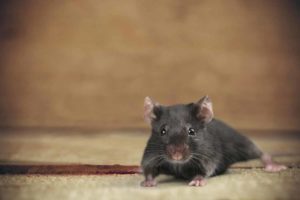
House Mouse
The name says it all. This widespread rodent, the most common mammal in the world, is content to live all of its days in your home or workplace, which makes it one of the most troublesome pests in the nation.
Appearance
- Two and a half to five inches in length
- One and a quarter to one and five-eights ounces in weight
- The tail is two to four inches long
- Light brown, gray, or black fur with lighter-colored underbellies
Behavior
- Usually nocturnal but will go out in daytime on occasion
- Likely to stay near familiar territory, no more than 30 feet from home or a food source
- Will enter a hole or crack as small as one-quarter inch
- Comfortable living around humans in buildings or homes
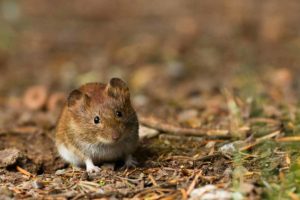
White-Footed Mouse
Your home won’t host this species, but the land surrounding your house may be enticing. The white-footed mouse will search for habitats outdoors where it can build a nest under rocks, piles of trash, or in old bird nests. The main concern associated with this species is the spread of Lyme disease and hantavirus.
The preferred habitat of the white-footed mouse ranges from southern New England to the southern U.S., the Midwest and western states, and Mexico.
Appearance
- Four to eight inches in length, with a tail measuring two to four inches
- Pale or reddish-brown fur with white underbelly and feet (hence its name)
- Closely resembles the deer mouse
Behavior
- Looks for dry, warm, wooded and brushy areas in which to live
- Not known to hibernate; active throughout the year
- Can travel across most terrain with ease due to their climbing and swimming skills
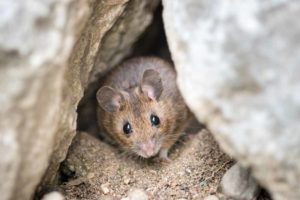
Deer Mouse
Found from Alaska to southern Mexico (but absent from the southeastern U.S.), the deer mouse is satisfied in all surroundings and elevations, though it’s most likely to enter human dwellings in autumn.
Appearance
- Roughly eight and a half inches in length
- Just under one and a half ounces in weight
- Grayish or reddish-brown fur with a white underbelly
Behavior
- Most active at night
- Nests near the ground in stumps, logs, brush piles, tree cavities, reconstructed bird nests, or tree bark
- During winter, may enter a sluggish state called torpor to reduce body temperature and conserve energy
A quick note about the differences between mice and rats: Mice are smaller and can enter smaller openings, making it tougher to proof your home against them. Mice also need little or no water for extended times and can reproduce faster than rats. Finally, house mice are often less sensitive to chemical poisons than rats. All of which can make ridding your home of mice more of a challenge.
Treating Your Property For Chipmunks
For solutions to help you treat against mice that have entered your home or land, look to these products.
DIY Treatments
If you’re concerned about using chemicals—especially if you have young children—there are a number of all-natural remedies and items in your pantry or laundry room that may be just as effective.
Peppermint Oil
The scent is a natural repellent to mice, yet a pleasing fragrance to humans. Place a dab on cotton balls and set them at suspected entry points and inside cabinets. Mice will beat a path away from the area. Make the deterrent more permanent by planting mint along the exterior of your home.
Want an alternative to peppermint? Mint leaves and mint toothpaste achieve the same effect.
Apple Cider Vinegar And Water
Spray a gentle mist of this mixture outside your home, and you’ll defend against mice, stink bugs, and spiders, too.
Tabasco Sauce And Soap Detergent
Now this is a pungent mix. Blend 2-3 tablespoons of Tabasco sauce and one cup of detergent in four liters of water. Spray the liquid wherever needed.
Cloves
Similar to peppermint, it’s all about the smell. Mice will run from it. You can either crush whole cloves and place them near where you suspect a mouse’s activity, or wet cotton balls with clove oil and put them in those areas.
Sealed-Off Foods
How do you frustrate mice? Lock up their food supply. Like we mentioned before, storing your food in airtight, plastic containers takes away a mouse’s favorite food source. This idea works for pet foods, too.
Used kitty litter
This may sound a bit yucky, but the logic is perfect. Since cats are natural predators of mice, the scent of a cat’s urine will make a mouse scurry away.
Steel Wool
Once you’ve located entry points, get creative. It’s one thing to plug them, quite another to use an item that actually hurts a mouse’s teeth. Steel wool accomplishes that. Apply a bit of silicone to keep it in place.
Dryer sheets – Set one in your pantry, cabinet space, and other parts of your kitchen. The chemicals in the cloth are offensive to mice.
Mice Problem?
When your living space becomes home to mice, the evidence is easy to find.
Common Locations
The Big Picture:
Globally, mice are tenacious creatures that live in most countries and a wide variety of terrain. If in the wild, mice will dig burrows to protect themselves from predators like cats, birds, and foxes. In rural areas, fields, fencerows, and barns offer hospitable environments, while homes, apartments, and businesses provide attics, basements, and wall voids as appealing spots for mice to live in developed areas.
Your Home Perimeter:
Large piles of grass clippings, tree trimmings or lumber, and yard debris make a fine outdoor home for mice. Spaces under trash cans or any accumulated junk can also become outdoor homes for mice.
Within Your Home:
Mice will even seek out small pockets of space behind furniture and appliances, in garages, and crevices—any nook that appears convenient for a nest and close to a food source. When your living space becomes home to mice, the evidence is easy to find: chewed wires, books, paper, and insulation.
Why? Because mice prefer to break down those materials to use in building their nests. They will happily construct their own living area from gnawed and scavenged household materials. This goes to show how comfortable mice are in the general presence of humans. That same behavior—incessant chewing—can lead to short circuits in wiring and other malfunctions that can damage your home.
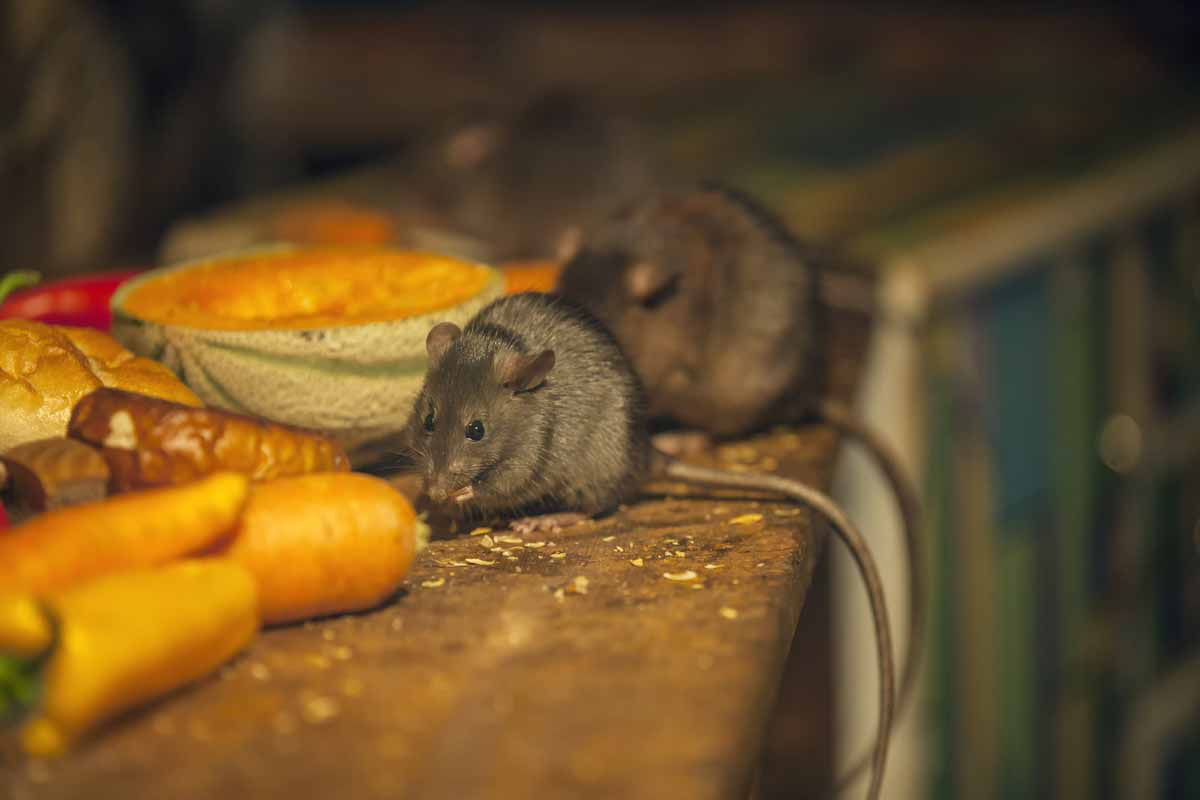
They’re known to eat insects, pet food, nearly anything humans eat, and every part of a plant.
Why They’re There
They want food. House mice eat animal and plant foods and have wide-ranging appetites. They’re known to eat insects, pet food, nearly anything humans eat, and every part of a plant. In other words, they’re not picky. They’ll even consume glue, soap (if it contains animal fat), and other household materials. Mice also enjoy snacking throughout the day. Food left in the open—whether for people or pets—may attract mice.
The same logic applies for outside your home as well. Mice will eat garbage, dog and cat food, dog feces, birdseed, and fruits or berries. When you remove these opportunities for feeding, mice will go elsewhere.
They’re looking for a place and time to breed. Like any animal, mice will seek a home in which to have and raise their young. Mice mate at any time of year—mostly between late spring and early fall—and females produce five to 10 litters of up to 15 offspring each year. The numbers add up quickly.
Beyond that, though, mice carry disease (we’ll discuss later), and their activity can damage your house. When you hear their movements at night inside your walls, you worry about what they’re doing to your home. Calling your local pest control professional is probably your first, best choice when you need to remove a family of mice.
Mouse Sounds
Mice are actually very vocal and communicative animals. While we hear their sounds as squeaks, they have a variety of squeaks and pitches that determine what they’re trying to communicate. Mind you, you’re more likely to notice a mouse by its scratching and scurrying sounds as it scampers inside walls, along baseboards, or in the attic.
Mouse Tracks
Like most rodents, mice have four toes on their front feet with a central pad, and five on their back, and their tiny tracks (half an inch or less) are accompanied by a tail trail.
Mouse Poop
Mice poop looks like small brown rice-sized pieces (about an eighth of an inch), usually scattered about rather than in piles. The more scattered, the more mouse problem you have.
A trap is a smart first choice and offers two advantages.
Inspect
Should I Relocate These Mice?
If you aim to move one or more mice out of your property, the only genuinely humane solution is the use of a live trap. This nonlethal method prevents the animal’s suffering and gives you the choice of where to release the mouse. Glue boards, snap traps, and other snares are cruel tactics for removing mice.
House mice that have lived their lives indoors aren’t likely to survive long in the wild. So your best option is to place them in some sheltered area away from your home. Deer mice will have a better chance of surviving after being relocated outdoors.
If you don’t feel comfortable handling relocation on your own, you should contact a pest control professional. They will have the right equipment and experience to safely and humanely extract mice from your home.
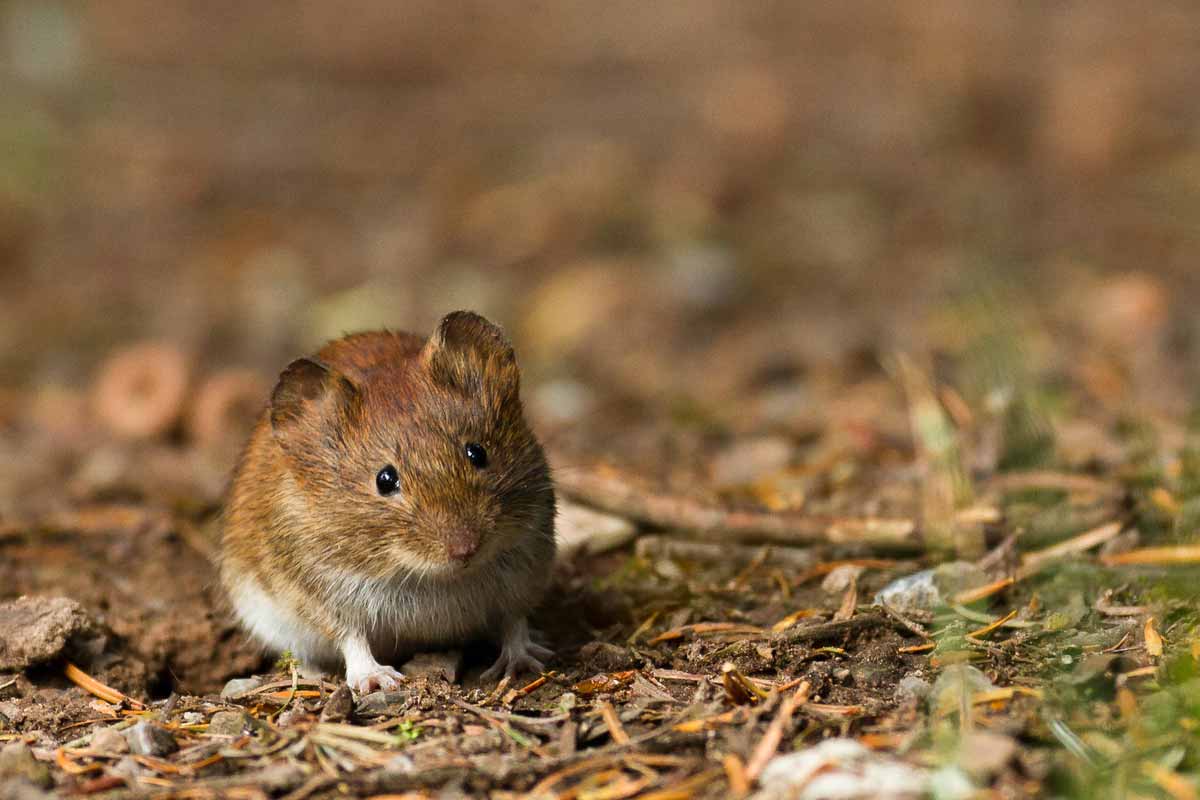
How-To Steps for DIY Removal
If you’re only seeing one mouse, or a minimal number of them, maybe you’ve decided to remove the pest(s) on your own. Between the ability of mice to carry disease, to reproduce, and to cause damage, clearing your home of troublesome creatures will give you peace of mind. Here are some options.
Give Them A Reason To Stay Outside.
Rodent control starts with the exterior of your home. A clean yard and trash cans covered by tight lids will deter mice from starting a nest in your yard with an eye toward your house. Situating your trash cans on a raised platform is an excellent way to make it harder for mice to reach food.
Set Traps Indoors.
When you’re dealing with one mouse or a small group—and you’re against the use of poisons—a trap is a smart first choice and offers two advantages. First, a trap allows you to see the mice you’ve captured and allowed for their removal on your terms. Second, you avoid potentially hazardous chemical or granule solutions.
As a homeowner, you should take the following steps when preparing a trap for mice:
Step 1: For best results, place a trap close to a wall, in a dark area, behind furniture, or wherever you’ve seen evidence of mouse activity.
Step 2: Bait each trap with a small piece of dried fruit, bacon, peanut butter, or a marshmallow. A small cotton ball may work as well since the mouse may hope to carry it away as nesting material. Whatever bait you use, don’t be too generous. Extra bait may end up attracting insects.
Step 3: Set enough traps so that you’re not reliant on just one location. Keep in mind that mice never travel far from their nest or a food source, so you should position the traps near a wall and no more than about six feet apart in the areas where you think the mice are active.
Step 4: Check the traps daily.
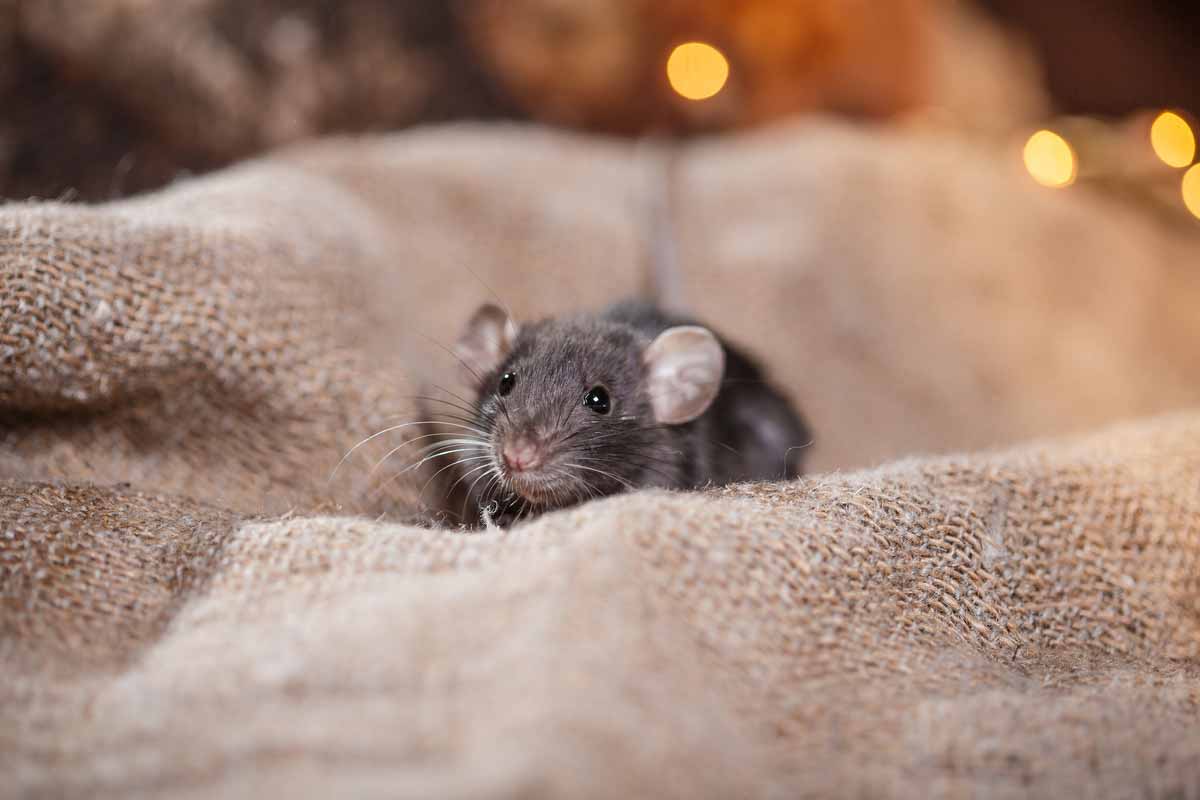
Treating Your Property For Chipmunks
For solutions to help you treat against mice that have entered your home or land, look to these products.
DIY Treatments
If you’re concerned about using chemicals—especially if you have young children—there are a number of all-natural remedies and items in your pantry or laundry room that may be just as effective.
Peppermint Oil
The scent is a natural repellent to mice, yet a pleasing fragrance to humans. Place a dab on cotton balls and set them at suspected entry points and inside cabinets. Mice will beat a path away from the area. Make the deterrent more permanent by planting mint along the exterior of your home.
Want an alternative to peppermint? Mint leaves and mint toothpaste achieve the same effect.
Apple Cider Vinegar And Water
Spray a gentle mist of this mixture outside your home, and you’ll defend against mice, stink bugs, and spiders, too.
Tabasco Sauce And Soap Detergent
Now this is a pungent mix. Blend 2-3 tablespoons of Tabasco sauce and one cup of detergent in four liters of water. Spray the liquid wherever needed.
Cloves
Similar to peppermint, it’s all about the smell. Mice will run from it. You can either crush whole cloves and place them near where you suspect a mouse’s activity, or wet cotton balls with clove oil and put them in those areas.
Sealed-Off Foods
How do you frustrate mice? Lock up their food supply. Like we mentioned before, storing your food in airtight, plastic containers takes away a mouse’s favorite food source. This idea works for pet foods, too.
Used kitty litter
This may sound a bit yucky, but the logic is perfect. Since cats are natural predators of mice, the scent of a cat’s urine will make a mouse scurry away.
Steel Wool
Once you’ve located entry points, get creative. It’s one thing to plug them, quite another to use an item that actually hurts a mouse’s teeth. Steel wool accomplishes that. Apply a bit of silicone to keep it in place.
Dryer sheets – Set one in your pantry, cabinet space, and other parts of your kitchen. The chemicals in the cloth are offensive to mice.
Mice Problem?
Certain Sounds Scare Mice.
Devices that produce ultrasonic noise can drive away mice. However, it’s possible the effect will be temporary and last no more than a few weeks.
Step 1: Locate the nest(s) of the mice.
Step 2: Place the ultrasonic device close enough to the nest that the noise reaches it directly. This kind of sound is very directional and doesn’t project well around corners.
Step 3: Check the mouse nest for signs the pests have abandoned the area.
Chemical Repellents Are Available.
Ropel is registered as a repellent against mice because it gives off a taste and odor that mice find very uncomfortable. However, there haven’t been enough studies to show whether Ropel will permanently drive out mice.
You should not handle a mouse without protective clothing.
Risks Of Disease
Unfortunately, mice can transmit serious diseases to humans—which is the greatest threat people face from these rodents. Thus, you should not handle a mouse without protective clothing.
Mice can carry bacterial and viral illnesses associated with ticks and fleas including:
Leptospirosis
Spreads through food or water contaminated with mouse droppings
Plague
Though rare, can be transmitted through a mouse bite
Salmonellosis (Food Poisoning)
Mouse urine and saliva carry the pathogen, which can linger on food and in kitchens
Hantavirus
Airborne particles from the droppings of deer mice (but not house mice) may carry this illness
Lyme Disease
During 2018, white-footed mice have been linked to the bacteria that cause this ailment
Each of these can be very dangerous to children, the elderly, or to people with weakened immune systems. And because mouse droppings or the body of a dead or dying rodent may carry disease, you should take the following actions to clean the area.
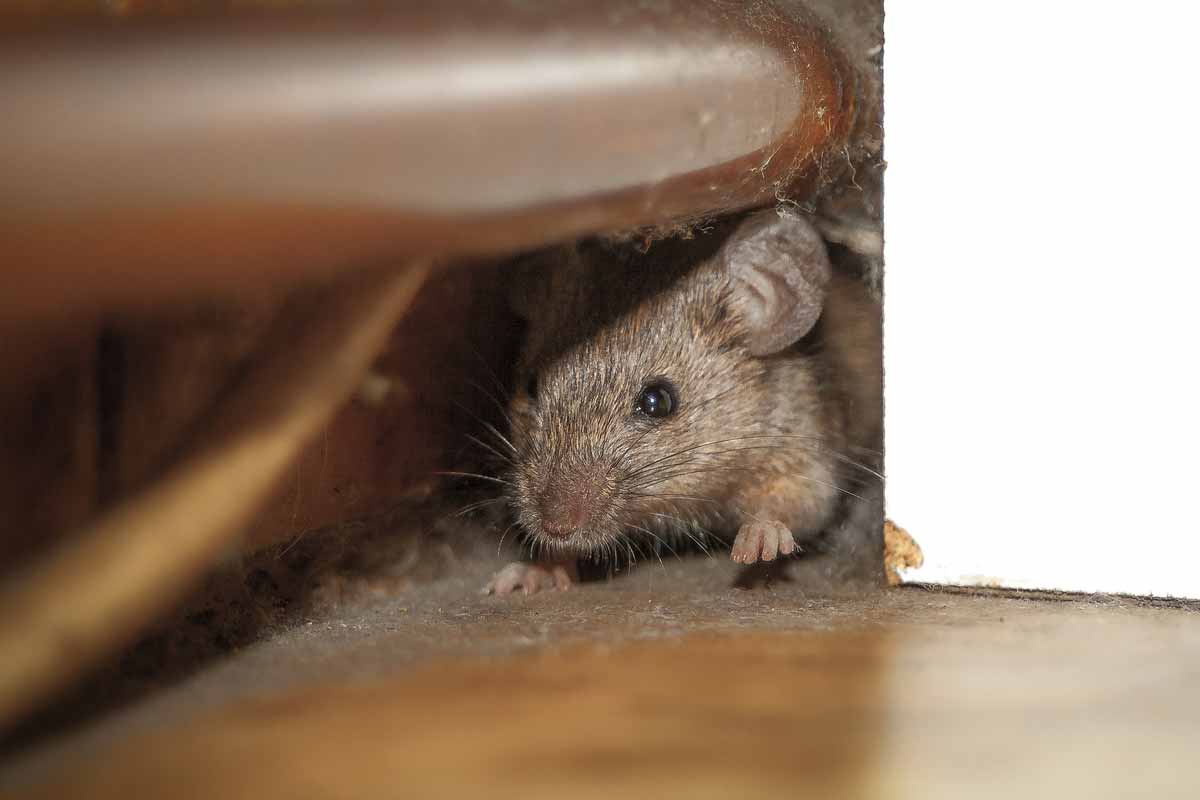
- If the mouse is dead, use rubber gloves or tongs to remove the rodent and its droppings by wrapping them in a plastic bag and placing them in a garbage can.
- If the mouse is injured or sick, the rodent should be killed quickly (drowning is easiest) and disposed of immediately.
- Wet the affected area with bleach water (one to two cups of bleach for each gallon of water), then sweep or vacuum away the mouse’s droppings.
- Spray the areas with bleach water and the also spray the trap(s), if any, that caught the mice.
- Wash your hands thoroughly with soap and warm water after ridding your home of the rodent—even if you used gloves.
Mouse Sounds
Mice are actually very vocal and communicative animals. While we hear their sounds as squeaks, they have a variety of squeaks and pitches that determine what they’re trying to communicate. Mind you, you’re more likely to notice a mouse by its scratching and scurrying sounds as it scampers inside walls, along baseboards, or in the attic.
Mouse Tracks
Like most rodents, mice have four toes on their front feet with a central pad, and five on their back, and their tiny tracks (half an inch or less) are accompanied by a tail trail.
Mouse Poop
Mice poop looks like small brown rice-sized pieces (about an eighth of an inch), usually scattered about rather than in piles. The more scattered, the more mouse problem you have.
Keep your focus on pipes, wiring, cables, doors, and windows.
Prevent
What steps do you take if your home had mice before and you want to keep them out—or if you want to avoid their entry from the start? Let’s discuss preventive measures.
Start Outside.
The technical term is “habitat modification.” It just means making your property less attractive to rodents by removing obvious nesting spaces. Regular lawn-mowing, clearing of debris and clutter, and removal of outdoor items, junk, or boxes will improve the look of your property and help to keep rodents away. If you feed your pets outdoors, seal up their food sources in airtight containers and clean up any leftovers.
Your Garage May Be A Mouse’s Home.
That’s because garage doors often don’t fit as well as doors in homes or apartments—and because garages accumulate items mice will consume as food or use as nesting materials. To prevent that from happening, store trash elsewhere in secure containers. Also, make a walking tour of the outside of your garage at night and shine a flashlight along the edge of the garage door to check for mouse-sized openings.
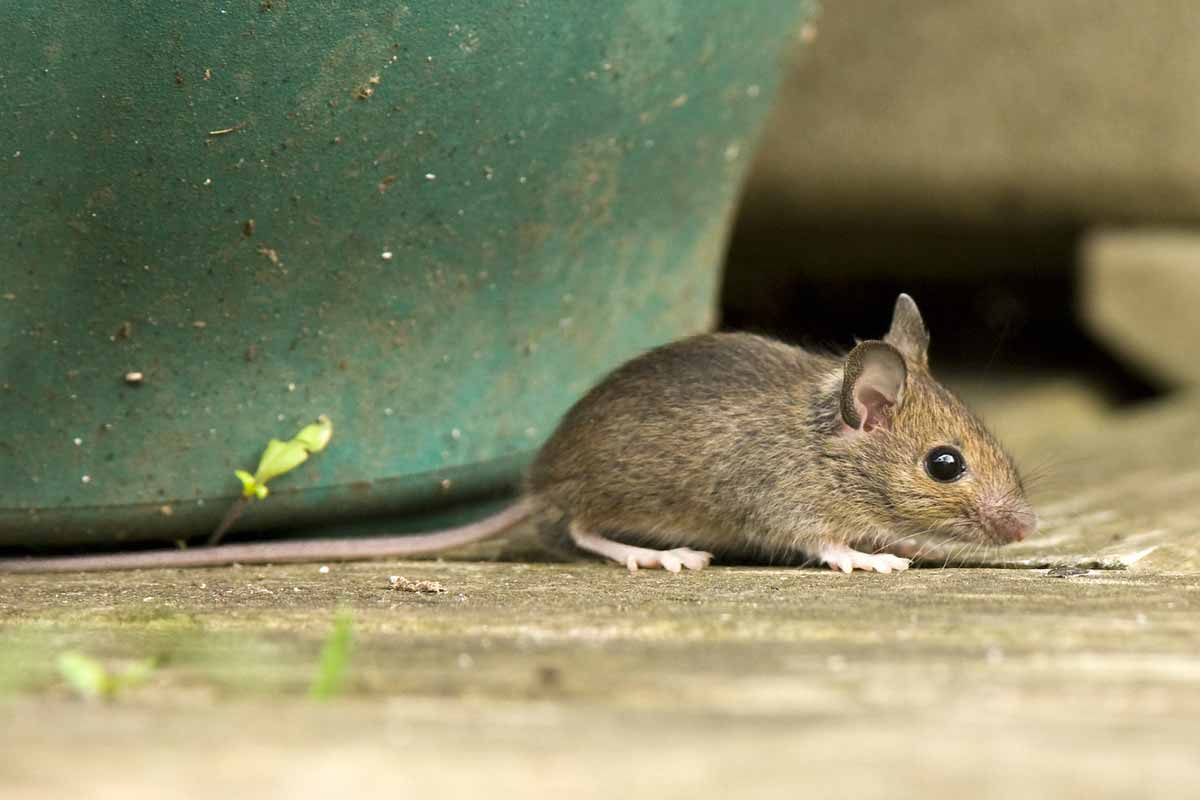
Speaking Of Doors And Windows,
Check to see they’re fitted properly, within no obvious gaps at the tops or bottoms. If you do see a large gap, weatherstripping provides a solution that can keep rodents and other pests out while also improving your home’s energy efficiency.
Treating Your Property For Chipmunks
For solutions to help you treat against mice that have entered your home or land, look to these products.
DIY Treatments
If you’re concerned about using chemicals—especially if you have young children—there are a number of all-natural remedies and items in your pantry or laundry room that may be just as effective.
Peppermint Oil
The scent is a natural repellent to mice, yet a pleasing fragrance to humans. Place a dab on cotton balls and set them at suspected entry points and inside cabinets. Mice will beat a path away from the area. Make the deterrent more permanent by planting mint along the exterior of your home.
Want an alternative to peppermint? Mint leaves and mint toothpaste achieve the same effect.
Apple Cider Vinegar And Water
Spray a gentle mist of this mixture outside your home, and you’ll defend against mice, stink bugs, and spiders, too.
Tabasco Sauce And Soap Detergent
Now this is a pungent mix. Blend 2-3 tablespoons of Tabasco sauce and one cup of detergent in four liters of water. Spray the liquid wherever needed.
Cloves
Similar to peppermint, it’s all about the smell. Mice will run from it. You can either crush whole cloves and place them near where you suspect a mouse’s activity, or wet cotton balls with clove oil and put them in those areas.
Sealed-Off Foods
How do you frustrate mice? Lock up their food supply. Like we mentioned before, storing your food in airtight, plastic containers takes away a mouse’s favorite food source. This idea works for pet foods, too.
Used kitty litter
This may sound a bit yucky, but the logic is perfect. Since cats are natural predators of mice, the scent of a cat’s urine will make a mouse scurry away.
Steel Wool
Once you’ve located entry points, get creative. It’s one thing to plug them, quite another to use an item that actually hurts a mouse’s teeth. Steel wool accomplishes that. Apply a bit of silicone to keep it in place.
Dryer sheets – Set one in your pantry, cabinet space, and other parts of your kitchen. The chemicals in the cloth are offensive to mice.
Mice Problem?
Mouse Sounds
Mice are actually very vocal and communicative animals. While we hear their sounds as squeaks, they have a variety of squeaks and pitches that determine what they’re trying to communicate. Mind you, you’re more likely to notice a mouse by its scratching and scurrying sounds as it scampers inside walls, along baseboards, or in the attic.
Mouse Tracks
Like most rodents, mice have four toes on their front feet with a central pad, and five on their back, and their tiny tracks (half an inch or less) are accompanied by a tail trail.
Mouse Poop
Mice poop looks like small brown rice-sized pieces (about an eighth of an inch), usually scattered about rather than in piles. The more scattered, the more mouse problem you have.
When to Call a Professional
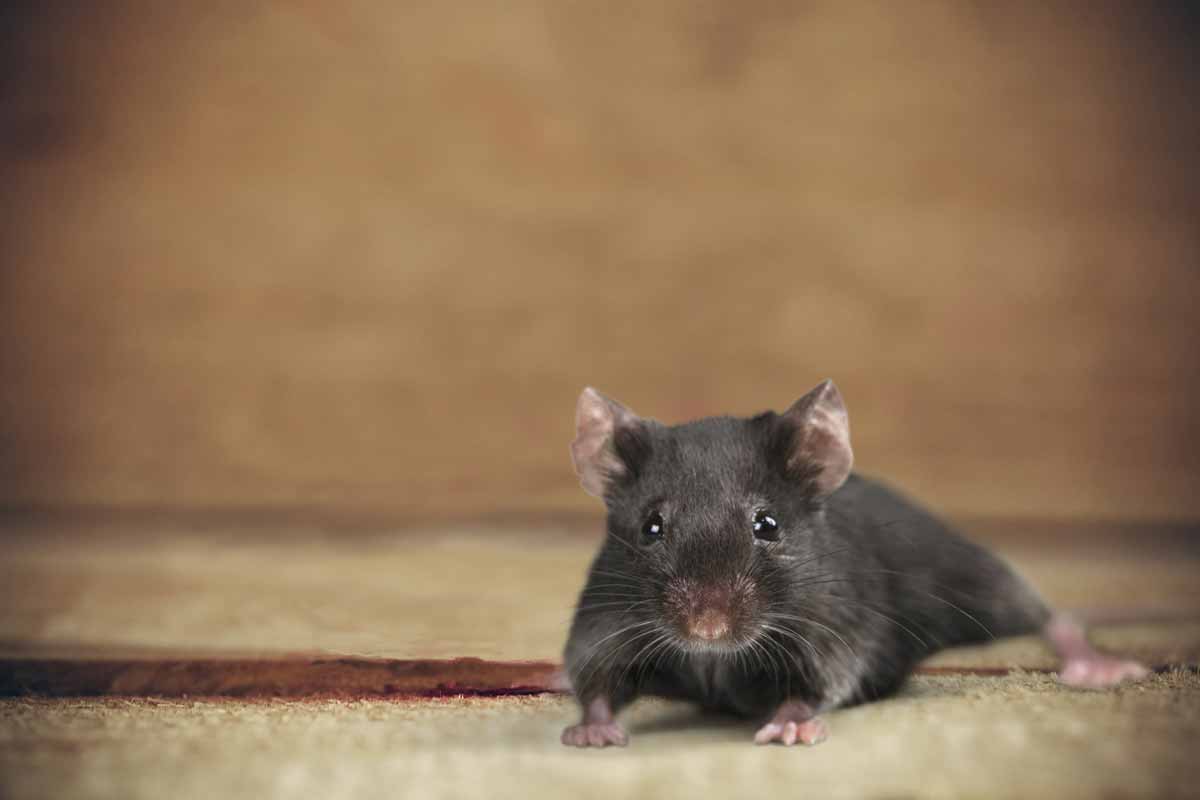
While it’s your call as a homeowner about when to contact a pest control professional, there are some instances when the decision should be quite obvious.
- If your DIY efforts have not been successful and you continue to see droppings
- Continuing sounds of mouse movement inside the walls of your home
- You now hear sounds in multiple places, which means the number of mice may have increased
- The traps you’ve placed have not been effective
When you talk with a specialist, you can provide a full picture of what you’re experiencing in your home and ask what you can reasonably expect regarding pest removal instead of extermination.
Sources
http://icwdm.org/handbook/rodents/HouseMice.asp
https://www.welcomewildlife.com/all-about-the-house-mouse/
https://www.cdc.gov/hantavirus/rodents/index.html
https://www.esf.edu/aec/adks/mammals/deer_mouse.htm
https://www.crittercontrol.com/services/mice/mice-problems
https://animaldiversity.org/accounts/Mus_musculus/
https://www.humanesociety.org/resources/what-do-about-wild-mice
https://www.crittercontrol.com/services/mice/what-diseases-do-mice-carry
https://www.in.gov/isdh/23256.htm
https://www.crittercontrol.com/services/mice/mouse-repellent
https://how-to-get-rid-of-mice.com/natural-home-remedies/
https://www.homeremedyhacks.com/18-home-remedies-to-get-rid-of-mice
Treating Your Property For Chipmunks
For solutions to help you treat against mice that have entered your home or land, look to these products.
DIY Treatments
If you’re concerned about using chemicals—especially if you have young children—there are a number of all-natural remedies and items in your pantry or laundry room that may be just as effective.
Peppermint Oil
The scent is a natural repellent to mice, yet a pleasing fragrance to humans. Place a dab on cotton balls and set them at suspected entry points and inside cabinets. Mice will beat a path away from the area. Make the deterrent more permanent by planting mint along the exterior of your home.
Want an alternative to peppermint? Mint leaves and mint toothpaste achieve the same effect.
Apple Cider Vinegar And Water
Spray a gentle mist of this mixture outside your home, and you’ll defend against mice, stink bugs, and spiders, too.
Tabasco Sauce And Soap Detergent
Now this is a pungent mix. Blend 2-3 tablespoons of Tabasco sauce and one cup of detergent in four liters of water. Spray the liquid wherever needed.
Cloves
Similar to peppermint, it’s all about the smell. Mice will run from it. You can either crush whole cloves and place them near where you suspect a mouse’s activity, or wet cotton balls with clove oil and put them in those areas.
Sealed-Off Foods
How do you frustrate mice? Lock up their food supply. Like we mentioned before, storing your food in airtight, plastic containers takes away a mouse’s favorite food source. This idea works for pet foods, too.
Used kitty litter
This may sound a bit yucky, but the logic is perfect. Since cats are natural predators of mice, the scent of a cat’s urine will make a mouse scurry away.
Steel Wool
Once you’ve located entry points, get creative. It’s one thing to plug them, quite another to use an item that actually hurts a mouse’s teeth. Steel wool accomplishes that. Apply a bit of silicone to keep it in place.
Dryer sheets – Set one in your pantry, cabinet space, and other parts of your kitchen. The chemicals in the cloth are offensive to mice.
Mice Problem?
Sources
https://www.earthkind.com/blog/mouse-sounds-mice-make-noise-squeaks-mean/
https://www.crittercontrol.com/services/mice/mouse-tracks
https://www.backpacker.com/skills/how-to-recognize-and-identify-animal-tracks-on-the-trail#section_4
http://www.animalatticpest.com/mousefeces.html
Mouse Sounds
Mice are actually very vocal and communicative animals. While we hear their sounds as squeaks, they have a variety of squeaks and pitches that determine what they’re trying to communicate. Mind you, you’re more likely to notice a mouse by its scratching and scurrying sounds as it scampers inside walls, along baseboards, or in the attic.
Mouse Tracks
Like most rodents, mice have four toes on their front feet with a central pad, and five on their back, and their tiny tracks (half an inch or less) are accompanied by a tail trail.
Mouse Poop
Mice poop looks like small brown rice-sized pieces (about an eighth of an inch), usually scattered about rather than in piles. The more scattered, the more mouse problem you have.





